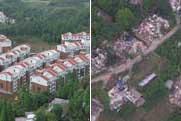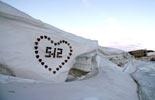World
Backgrounder: Major disagreements in Israeli-Palestinian peace talks
Source: Xinhua | 11-28-2007 11:24
Special Report: Mideast Peace ConferenceBEIJING, Nov. 27 (Xinhua) -- Representatives from over 40 nations, regions and international organizations meet in Annapolis in the U.S. state of Maryland Tuesday in a bid to relaunch the long-stalled Middle East peace process.
Major stumbling blocks in the peace process include the status of Jerusalem, the border of a future Palestinian state, the Jewish settlements, the fate of Palestinian refugees and the distribution of water resources in the region.
STATUS OF JERUSALEM
Located in the heart of the Middle East, Jerusalem is the holy city for three major religions: Judaism, Christianity and Islam.
According to UN General Assembly Resolution 181 adopted in 1947,Jerusalem should be run by the United Nations as an internationalized city.
After the first Israeli-Arab war in 1949, Jerusalem was cut into two parts by a ceasefire line running from north to south, with the eastern part occupied by Jordan and the western part occupied by Israel.
In 1967, Israel swept to victory over its Arab neighbors in the Six Day War and took control of East Jerusalem.
In 1980, the Israeli parliament adopted a bill to establish Jerusalem as its permanent capital.
Palestine has claimed since the 1960s that Jerusalem is part of its territory and Israel must give up control of the city.
In November 1988, the Palestinian National Council announced the independence of a Palestinian State, with Jerusalem as its capital.
BORDER ISSUE
UN General Assembly Resolution 181 called for a two-state solution in the region, slating 14,900 square km of land for a Jewish state and 11,500 square km of land for an "Arab state."
The Jews established their country in 1948, while the Arabs refused to follow the UN resolution.
During the first and third Israel-Arab wars, Israel took all the territory of the "Arab state," including the West Bank, Gaza Strip and East Jerusalem.
Later, the UN Security Council adopted resolution 242 and 338, calling for the "withdrawal of Israeli armed forces from territories occupied in the recent conflicts."
The Palestinians have insisted on building an independent state within the border as before the Six Day War in 1967, which was contested by the Israeli government.
JEWISH SETTLEMENTS
Israel began to build settlements on the occupied land after the 1967 war. In the following decades, more than 200 settlements were built.
In the long-running Middle East peace talks, Palestinians asked the Israeli side to withdraw from those settlements.
Israel completed withdrawal from all 21 settlements in the Gaza Strip and four on the West Bank in 2005, still leaving over 100 settlements in the West Bank.
FATE OF PALESTINIAN REFUGEES
The Israeli-Arab wars left over 1 million Palestinians homeless. According to UN data, up until 2005, the number of registered Palestinian refugees exceeded 4.4 million. In addition to the West Bank and the Gaza Strip, these refugees were also concentrated in Jordan, Lebanon and Syria.
According to UN General Assembly Resolution 194 adopted in 1948,Palestinian refugees are entitled to return to their homeland. However, Israel insists the refugees stay where they are as their return may greatly change the regional demographics and create security concerns.
DISTRIBUTION OF WATER RESOURCES
Israelis have 80 percent of all the water resources of the arid region while Palestinians take 20 percent. Faced with increasing population and water consumption, Palestinians have determined to reclaim all the water facilities in the West Bank and Gaza Strip while the Israelis insist on co-management of the water resources so as to avoid water insecurity.
Editor:Zhang Pengfei



